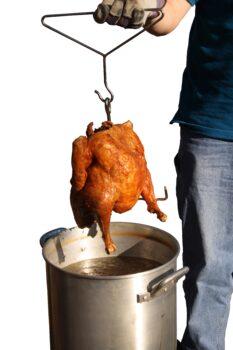Breaux’s Fried Turkey
This recipe comes from my late uncle Harris Breaux Jr. who was lauded for his outdoor cooking skills. Although indoor, small-appliance turkey fryers exist now, most people still fry turkeys the old-fashioned way, using a very large, deep pot over a propane burner. If you choose to use this recipe, please insure that your fryer is not near the house, on a porch, or under an overhang of any type. And don’t overfill the pot with oil. When the turkey is submerged in oil, there should be at least five inches of space between the fill line of the oil and the top of the pot.
Deep-frying a turkey. Shutterstock





